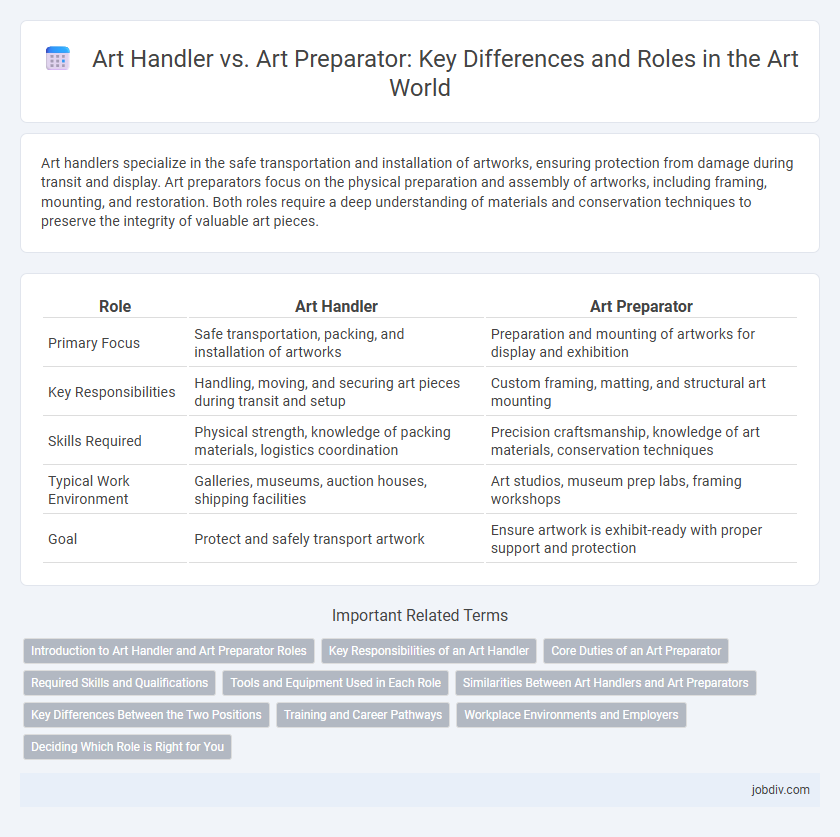Art handlers specialize in the safe transportation and installation of artworks, ensuring protection from damage during transit and display. Art preparators focus on the physical preparation and assembly of artworks, including framing, mounting, and restoration. Both roles require a deep understanding of materials and conservation techniques to preserve the integrity of valuable art pieces.
Table of Comparison
| Role | Art Handler | Art Preparator |
|---|---|---|
| Primary Focus | Safe transportation, packing, and installation of artworks | Preparation and mounting of artworks for display and exhibition |
| Key Responsibilities | Handling, moving, and securing art pieces during transit and setup | Custom framing, matting, and structural art mounting |
| Skills Required | Physical strength, knowledge of packing materials, logistics coordination | Precision craftsmanship, knowledge of art materials, conservation techniques |
| Typical Work Environment | Galleries, museums, auction houses, shipping facilities | Art studios, museum prep labs, framing workshops |
| Goal | Protect and safely transport artwork | Ensure artwork is exhibit-ready with proper support and protection |
Introduction to Art Handler and Art Preparator Roles
Art handlers specialize in the safe transportation, installation, and packing of artworks, ensuring the integrity of valuable pieces during movement and storage. Art preparators focus on the physical maintenance, framing, and mounting of artworks for exhibition, working closely with curators to prepare pieces for display. Both roles require detailed knowledge of materials, conservation techniques, and handling protocols to preserve and present artworks professionally.
Key Responsibilities of an Art Handler
Art handlers specialize in the careful transportation, installation, and packing of artworks, ensuring their safety and protection during exhibitions and relocations. They must possess expertise in handling delicate and valuable art pieces, utilizing appropriate materials and techniques to prevent damage. Their key responsibilities include meticulous inventory management, condition reporting, and collaboration with curators and preparators to maintain the integrity of collections.
Core Duties of an Art Preparator
Art preparators specialize in assembling, installing, and maintaining artworks for exhibitions, ensuring proper handling and preservation techniques are applied to prevent damage. They collaborate closely with curators and conservators to adapt display methods that support the artwork's integrity and aesthetic presentation. Precision in rigging, custom mounting, and environmental control are essential aspects of their core duties to safeguard valuable collections.
Required Skills and Qualifications
Art handlers require strong physical stamina, knowledge of proper packing, handling, and transportation techniques, and familiarity with museum-grade materials to ensure artwork safety. Art preparators need specialized skills in installation, condition reporting, and various mounting methods, often requiring experience with tools and materials used in framing and display construction. Both roles benefit from expertise in art conservation principles, attention to detail, and the ability to work collaboratively within museum or gallery environments.
Tools and Equipment Used in Each Role
Art handlers primarily use specialized packing materials, custom crates, and lifting equipment like forklifts and dollies for safe transportation and installation of artworks. Art preparators focus on tools such as framing devices, conservation brushes, adhesives, and climate control instruments to prepare and preserve artworks for display. Both roles require precision tools tailored to the artwork's medium, but handlers emphasize logistics while preparators prioritize preservation and presentation techniques.
Similarities Between Art Handlers and Art Preparators
Art handlers and art preparators both play essential roles in the safe transportation, installation, and maintenance of artworks within galleries, museums, and exhibitions. Both professionals require expertise in handling delicate materials, understanding proper packing techniques, and ensuring environmental conditions to preserve the integrity of art pieces. Their collaboration ensures artworks are securely moved and displayed while minimizing damage risks during handling and installation processes.
Key Differences Between the Two Positions
Art handlers primarily focus on the safe transportation, packing, and installation of artworks, ensuring physical protection during transit and display. Art preparators specialize in the technical and conservation aspects, including framing, mounting, restoration, and environmental monitoring to preserve the artwork's integrity. While both roles require expertise in handling art, art preparators demand a deeper understanding of materials and preservation techniques compared to the logistical emphasis of art handlers.
Training and Career Pathways
Art handlers typically undergo specialized training in logistics, packing, and transporting artwork, often starting with apprenticeships or vocational courses focused on preservation techniques. Art preparators usually pursue formal education in fine arts or museum studies, emphasizing skills in installation, condition reporting, and materials conservation. Career pathways for art handlers often lead to roles in galleries or shipping companies, while preparators may advance to curatorial or conservation positions within museums and art institutions.
Workplace Environments and Employers
Art handlers primarily work within galleries, museums, and auction houses, managing the transportation, packing, and installation of artworks in climate-controlled, secure environments. Art preparators are often employed by the same institutions but focus on studio or workshop settings where they condition, restore, and prepare pieces for display or shipment. Both roles require collaboration with curators and conservators, but art preparators typically engage more directly with conservation studios, while art handlers operate predominantly in logistical and exhibition spaces.
Deciding Which Role is Right for You
Art handlers specialize in the safe transportation, installation, and packing of artworks, requiring physical strength and attention to detail for handling delicate pieces. Art preparators focus on the technical and aesthetic preparation of art displays, including framing, mounting, and lighting, demanding skills in carpentry and visual presentation. Choosing the right role depends on your interest in physical logistics versus artistic craftsmanship within museum or gallery settings.
Art Handler vs Art Preparator Infographic

 jobdiv.com
jobdiv.com